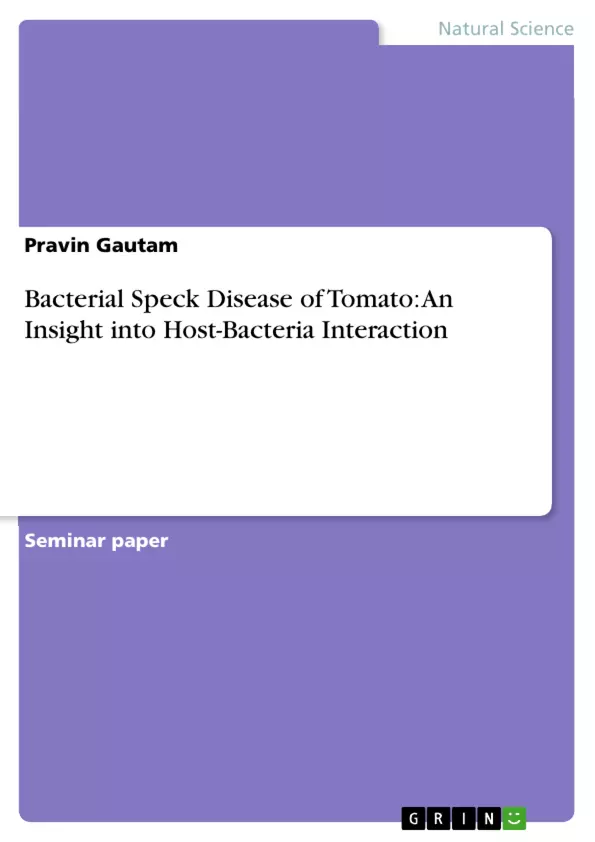Pseudomonas syringae pv. tomato (Pst) is a common pathogen of tomato which causes bacterial speck disease. This disease serves as a useful model for studying the interactions of microbial pathogens and plants. Most gram-negative bacteria, including Pst, have type III secretion system (TTSS). Encoded by hrp gene clusters, the TTSS is used to deliver effector proteins into the host cytosol. The hrp genes also control the expression of the avirulence genes (avr). One Avr protein, AvrPto, functions as ligand to elicit a hypersensitive response (HR) in the tomato plant after recognition by the protein encoded by the host resistance gene, Pto. The AvrPto-Pto interaction is the most widely studied systems. It has been discovered that Pto is linked with Fen, the gene responsible for susceptibility to an organophosphate insecticide, fenthion. Functioning of Pto requires another gene called Prf, which lies embedded in Pto. Though the system is well characterized, several aspects are still not understood. With the availability of completed genome sequence of Pst and the full sequence of tomato expected in the future, we may anticipate that our understanding of the mechanisms of this host-pathogen interaction to be improved.
Inhaltsverzeichnis (Table of Contents)
- Summary
- Biological aspect of interaction
- Physiological Alterations in the Participants
- Molecular Biology and Molecular Genetics
Zielsetzung und Themenschwerpunkte (Objectives and Key Themes)
This paper explores the complex interaction between the bacterial pathogen *Pseudomonas syringae* pv. *tomato* (Pst) and tomato plants, focusing on the bacterial speck disease it causes. The main objective is to provide insights into the molecular mechanisms underlying this host-pathogen interaction, particularly the roles of the type III secretion system (TTSS), effector proteins, and the Pto resistance gene.
- The bacterial speck disease of tomato and the role of *P. syringae* pv. *tomato* (Pst)
- The type III secretion system (TTSS) and its role in delivering effector proteins
- The AvrPto-Pto interaction and its role in eliciting a hypersensitive response (HR)
- The physiological alterations in both the pathogen and host plant during infection
- The molecular mechanisms of resistance and susceptibility in tomato plants
Zusammenfassung der Kapitel (Chapter Summaries)
The paper begins by summarizing the symptoms and characteristics of bacterial speck disease, highlighting the importance of the pathogen's ability to enter the host plant through stomata and wounds. It then delves into the communication between Pst and the tomato plant, exploring the role of the toxin coronatine (COR) in promoting bacterial entry by re-opening stomata.
The text further examines the physiological changes that occur in both the pathogen and the host plant during infection. The paper discusses how Pst injects effector proteins into the host cytosol via the TTSS, resulting in up- and down-regulation of various host genes that alter the physiology of infected cells. This includes changes in cell wall composition, oxidative burst, and the induction of defense mechanisms.
Finally, the paper delves into the molecular biology and genetics of the Pst-tomato interaction. It provides detailed information about the TTSS, including its structure, function, and the genes involved in its regulation. The paper also explores the role of the avirulence gene *avrPto* and the resistance gene *Pto* in the gene-for-gene model of host-pathogen interaction. It further discusses the discovery of the *Prf* gene and its role in Pto-mediated resistance.
Schlüsselwörter (Keywords)
The paper focuses on key terms and concepts such as bacterial speck disease, *Pseudomonas syringae* pv. *tomato* (Pst), type III secretion system (TTSS), effector proteins, hypersensitive response (HR), AvrPto, Pto, Prf, coronatine (COR), and gene-for-gene model. These terms are essential for understanding the complex molecular mechanisms involved in the interaction between Pst and tomato plants.
- Quote paper
- Pravin Gautam (Author), 2008, Bacterial Speck Disease of Tomato: An Insight into Host-Bacteria Interaction, Munich, GRIN Verlag, https://www.grin.com/document/178581



